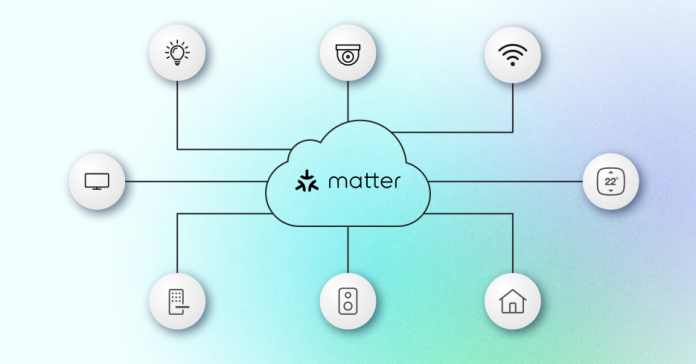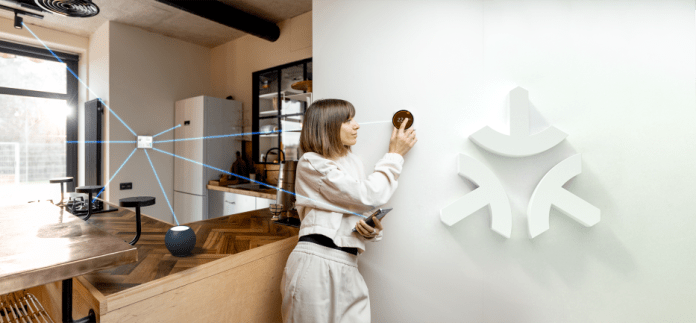What is Matter? Historically, smart-home devices have been scattered across several ecosystems, presenting challenges for both consumers and manufacturers. In an ideal world, devices should give users more leverage over their lives and be less of a headache to set up and integrate into the home. In 2022, the Connectivity Standard Alliance (CSA) released Matter 1.0, a connectivity standard that enables IoT devices from different manufacturers and providers to work together seamlessly. As a member of the CSA, Silicon Labs has been driving the Matter standard forward since its inception and has provided 20% of Matter’s source code.
Simplifying consumer setup
Before Matter, consumers had difficulty choosing the right smart-home device because there was no guarantee that all devices would work with the hub they already owned. Because of this, they could either purchase smart-home devices within the same ecosystem or acquire multiple smart-home hubs to use devices in different ecosystems. For example, attempting to pair a Z-Wave door lock with an Amazon Alexa hub would not work. These issues could quickly become very expensive and difficult for consumers to manage.
The Matter protocol solves this issue and enables advanced interoperability from numerous ecosystem vendors (such as Apple, Amazon and Google) to work seamlessly, locally, securely and reliably. Matter’s flagship feature is that it will help simplify the lives of smart-home consumers—and the benefits are almost instantaneous.

The Matter protocol enables IoT devices from different manufacturers and providers to work together seamlessly.
Consumers can expect easy, secure setup processes with lower costs because it is no longer necessary to purchase a new hub for every ecosystem. Adding to interoperability, the Multi Admin feature allows different members of the same household to manage which devices they share on which systems, all on an individual level. Matter uses a variety of cryptographic mechanisms to ensure it can authenticate consumers’ devices for enhanced security. With Matter, consumers have the freedom to choose the smart-home devices and brands they love—from individual devices to the main hub.
Matter has widened the smart-home device marketplace and will usher in a host of benefits for device manufacturers and developers, including new streamlined processes and more leverage to reduce development, production costs and time. Matter works on local connectivity and is IP-based, allowing developers to choose which protocols, such as Wi-Fi or Thread, to fit their application.
Matter’s Bluetooth support easily allows consumers to commission devices from their phone. This will help to level the IoT playing field, ushering in a new era of competition among device manufacturers looking to differentiate their products. These include Silicon Labs’ complete Matter development solutions and MG24 wireless SoC, which will help simplify manufacturers’ growing needs.
Unifying device development
Prior to Matter, individual manufacturers needed to take additional steps to ensure different devices could communicate in the same home network using each of the proprietary ecosystem protocols. These separate protocols required product makers to choose which ecosystem they wanted their device to support or build different versions of the same product for each ecosystem, which was costly and time-consuming.
The Matter standard addresses these issues by unifying device development and requiring only one SKU per product. Unifying the application layer has a substantial economic benefit for smart-home device developers and manufacturers because it lowers operational and development costs, simplifies the entire supply chain and will likely improve bottom lines.
Now, even smaller commercial home product developers can connect with larger IoT ecosystems due to the benefit that Matter uses open-source software and can leverage the mobile apps developed by other providers. Developers can also benefit from trusted IP class security, which gives consumers peace of mind.

Matter uses open-source software and leverages mobile apps to ensure interoperability across smart-home devices.
Matter will help accelerate smart-home adoption and improve revenue streams for manufacturers by making the details of wireless connectivity easy, leaving more time for manufacturers to create products with improved quality and value.
Differentiating new devices
With Matter now helping to reduce the ecosystem-based barriers to entry for new devices, wireless connectivity, security, energy use or battery life and computing capabilities are still critical to help consumers differentiate the hundreds, if not thousands, of devices available for purchase. As an example, Silicon Labs has extensive experience designing chips that support smart-home technologies, and the MG24 wireless SoCs can help developers take advantage of Matter in their new designs in five ways: strong wireless performance, high-level intelligence, energy efficiency, enhanced security and long-lasting devices.
Manufacturers and developers can create unique smart-home products by turning common challenges like poor wireless performance into opportunities to differentiate. This includes providing support for the Thread protocol for Matter with high link budgets to ensure strong wireless performance.
Another challenge manufacturers need help with is the growing demand for high-level intelligence in smart-home products. This need creates an opportunity for differentiation and requires new artificial-intelligence and machine-learning capabilities in smart-home products. This includes wireless SoCs with built-in AI/ML hardware accelerators that enable fast ML inferencing with lower energy consumption, allowing developers to pack more intelligence into battery-powered products.
A lack of energy-efficient products is yet another challenge developers face. According to the U.S. Environmental Protection Agency (EPA), Americans purchase almost 3 billion batteries to power smart items, but only 5% are recycled globally. Manufacturers can address this issue by creating energy-efficient wireless devices with less battery waste and longer replacement and recharging intervals by incorporating wireless SoCs with ultra-low active and sleep currents that can run for several years with a coin-cell battery, helping smart-home device developers make longer battery life a differentiator against competitors.
The top customer concern in the smart-home landscape is privacy, and a single breach can easily harm product sales and cause material damage to a device maker’s brand. Therefore, providing enhanced security like Secure Vault and PSA Certified Level 3 security to ensure consumer trust is another way for developers to differentiate their new, Matter-enabled products.
Developers must also consider sustainability as consumers prioritize the environmental impact of their products and demand long-lasting smart-home devices to avoid waste. This includes accommodating a large memory capacity and providing over-the-air updates to handle future software updates, protocol versions and security patches, as well as offering product longevity support.
Thanks to Matter, developers and manufacturers can now unlock the smart home’s full potential. The standard helps pave the way for IoT innovation by addressing previous smart-home technology limitations, increasing competition in the market and allowing developers to focus on creating innovative products that simplify the consumer experience.
Rob Alexander has worked on IoT devices, wireless protocols and embedded devices for more than 16 years. Previously, he worked as a principal architect at Silicon Labs, working with various embedded software teams and customers to integrate wireless stacks and applications into Silicon Labs hardware and software. In addition, Rob served as chair of the Zigbee Pro Core Workgroup from 2013 to 2022, which standardized the Zigbee mesh networking layer, application transport layer and interactions with the IEEE 802.15.4 MAC layer. Rob also serves on the CSA Board of Directors (formerly Zigbee Alliance) and the Thread Group Board of Directors. Rob is currently the Silicon Labs principal product manager for Matter.
Advertisement





